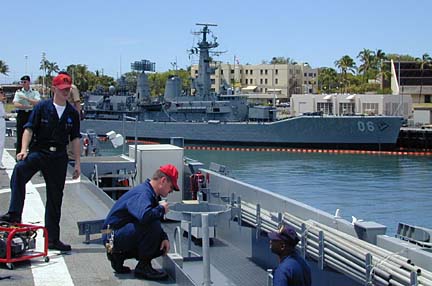Advertisement - Click to support our sponsors.

Navy to test new
computer network
Coalition Wide Area Network
links ship and shore facilities,
which share information via
special secure Web sitesNavy ships to stand-in for Hollywood
By Gregg K. Kakesako
Star-BulletinTHE Navy will test a new computer network during this month's RIMPAC naval exercise that will be linked by commercial satellite.
It will tie communications systems on more than 50 warships from six Pacific Basin countries in the war games.
Dubbed Coalition Wide Area Network, the system uses off-the-shelf commercial computers, servers, routers, computer software and satellite communications to link ship and shore facilities, said Vice Adm. Dennis McGinn, RIMPAC and the Navy's 3rd Fleet head.
"The system brings all of our coalition partners in a private network," McGinn said.
This allows the 3rd Fleet to send and receive information, voice and visual data to and from the warships through special secure Web pages. The exercise began Tuesday and will run through July 6.

"This means we can very quickly disseminate information. ... This will foster better decisions based on more current information."Also being tested for the first time is a major humanitarian and disaster relief exercise, Strong Angel, which will be set up and run on the Big Island from June 6-15 in conjunction with several civilian organizations, including the American Red Cross.
More than 175 Red Cross volunteers, ranging in age from 13 to 75, will portray refugees who will be housed at a camp built on barren land near the Puu Paa cinder cone in Waimea. The "refugees" will occupy the camp from June 11-15.
A civilian military operations center will be established on McGinn's command ship, the USS Coronado, and will be later relocated to Waimea during the refugee disaster exercise. The center will be manned by civilian and military officials.

"We are taking lessons learned from real-world operations," said Cmdr. Allen Stubblefield, RIMPAC exercise planner, "and incorporated them into our plan."Twenty-eight U.S. warships will join 10 Japanese vessels, five each from Australia and Canada, three from South Korea and a frigate from Chile.
Australia and Canada have each deployed about 1,000 personnel to the islands, with 1,500 coming from Japan, 500 from South Korea, 300 from Chile and 70 from the United Kingdom.
About 17,700 U.S. personnel are involved in the 17th series of biennial exercises.
Navy ships to stand-
Star-Bulletin staff
in for HollywoodRIMPAC and the U.S. Pacific Fleet this month will play a key role in Hollywood's version of the events surrounding the Japanese attack on Pearl Harbor on Dec. 7, 1941.
Twenty ships, including the nuclear supercarrier Abraham Lincoln, participating in the current Rim of the Pacific naval exercise will serve as cinematic doubles for the Japanese Imperial Navy, which launched the 1941 strike on the Hawaiian Islands.
Cmdr. Allen Stubblefield, 3rd Fleet spokesman, said Disney, producers of the $135 million World War II epic, "Pearl Harbor," will film the Lincoln and other naval vessels from the air June 18. "Then they plan to rework the images to look like it was back then," he said.
Disney cameramen also will shoot aerial photos of the six navies now in Hawaiian waters for RIMPAC.
Filming also will take place aboard the USS Lexington, which is now a floating museum in Corpus Christi, Texas.